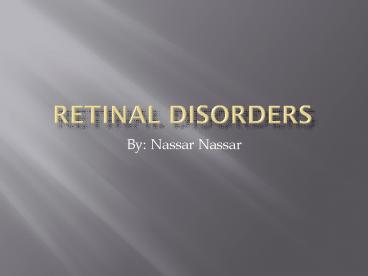Retinal Disorders - PowerPoint PPT Presentation
1 / 20
Title: Retinal Disorders
1
Retinal Disorders
- By Nassar Nassar
2
ANATOMY
3
(No Transcript)
4
Retina as seen through an ophthalmoscope
5
Gross Anatomy
- Nervous coat of the eyeball
- Outer surface is attached to the choroid
- Inner surface is attached to the vitreous body
- Ends as wavy line ora serrata
- Macula
- Oval, yellowish area at center of posterior part
- High concentration of cones
- It includes the Fovea Centralis
- Optic Disk
- 3mm medial to macula
- Pierced by the central artery of retina
- Blind Spot
- Leave as optic nerve
6
Layers
- Outermost retinal pigment epithelium (RPE)
single layer and is not part of the retina - Most books say htat the retina is 10 layers but
grossly it is infact 3 layers. - Innermost neuroretina
- Ganglion cell layer, axons form optic nerve
- Bipolar nerve layer
- Photoreceptors (cons rods)
7
(No Transcript)
8
Photoreceptors
- Convert light into electrical signals
- Rods
- For night vision
- Do not signal wavelength information (color)
- Cones
- For daylight and color vision
- High threshold to light
- Concentrated at the fovea
9
Direction of Light
- Light pass through the ganglion and bipolar
layers before reaching the photoreceptors in all
areas of the retina except the fovea. - In the fovea, the bipolar and ganglion cell
layers are pulled aside so that light strikes the
photoreceptors directly.
Visual Processing
10
SYMPTOMS OF RETINAL DISEASES
11
Macular Dysfunction
- Disorder of the central part of the macula
(fovea) causes significant visual impairment. The
patient may complain of - Blurred central vision
- Distorted vision (metamorphopsia) micropsia or
macropsia, occur if the photoreceptors become
stretched apart or close together. - Areas of loss of central visual field
(scotomata), if part of the photoreceptor layer
becomes covered, e.g. by blood, or if the
photoreceptors are destroyed.
12
Blurred central vision
Scotomata
Metamorphopsia
13
Peripheral Retinal Dysfunction
- The pt. complains of
- Loss of visual field, detected clinically.
- Some diseases may predominantly affect one type
of photoreceptors, ex. Retinitis pigmentosa and
night vision.
14
ACQUIRED MACULAR DISEASES
15
Age-related macular degeneration (AMD)
- The commonest cause of irreversible visual loss
in the developed world. - Associated with increasing age and is typically
bilateral - Pathogenesis
- Overtime undigested lipid products deposits in
Bruchs membrane, seen as yellow lesions called
drusen. - Collection of drusen in the macula is termed age
related maculopathy (ARM) - Dry form the neighboring RPE and photoreceptors
show degenerative changes - Wet/Exudative form angiogenic factors (ex. VEGF)
stimulate new vessel formation from the choroid
through Bruchs membrane and RPE into the sub
retinal space forming sub-retinal neovascular
membrane.
16
AMD cont.
17
(No Transcript)
18
AMD cont.
- Symptoms
- Symptoms of macular dysfunction
- Progressive, gradual loss of central vision
leading to difficulty in reading and recognizing
distant objects - In the wet form, visual disturbance is sudden
- Signs
- Yellow, well-circumscribed drusen
- Areas of hypo/hyperpigmentation
- Loss of foveal reflex
- In wet, pre-retinal (more occasionally) or
subretinal hemorrhage
19
AMD cont.
- Investigations
- Diagnosis is based on the appearance of the
retina. - In suspected exudative AMD and vision not
severely affected a fluorescein angiogram may be
performed to delineate the position of the
sub-retinal neovascular membrane. - Prognosis
- Dry AMD progress very slowly , increasing
difficulty in reading - Wet AMD 75 of pt.s experience marked
deterioration of vision over a 3 year time frame.
20
AMD cont.
Wet AMD
Fluorescein Angiogram of Wet AMD































